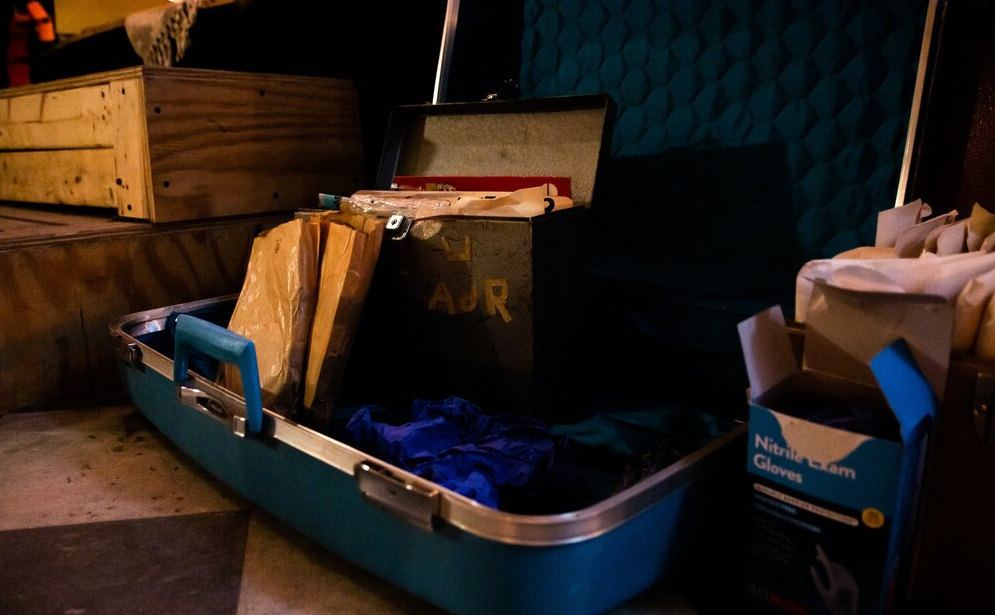I spoke with members of Bare Portland prior to a rehearsal for [Storage], their new installation and performance experiment built on an immersive set within the former Maine Girls Academy. We talked about their newfound understanding of the storage industry, the ethical complexity of using the contents of an abandoned storage unit to create art exploring gentrification, and how a project with 18 artists and countless community collaborators forced their theater company to radically transform their process.
Contributing [Storage] artists present: Catherine Buxton, Dana Hopkins, Kate Hunter, James Patefield, Tarra Bouchard, Douglas Milliken, Kerry Anderson, and Mackenzie O’Connor
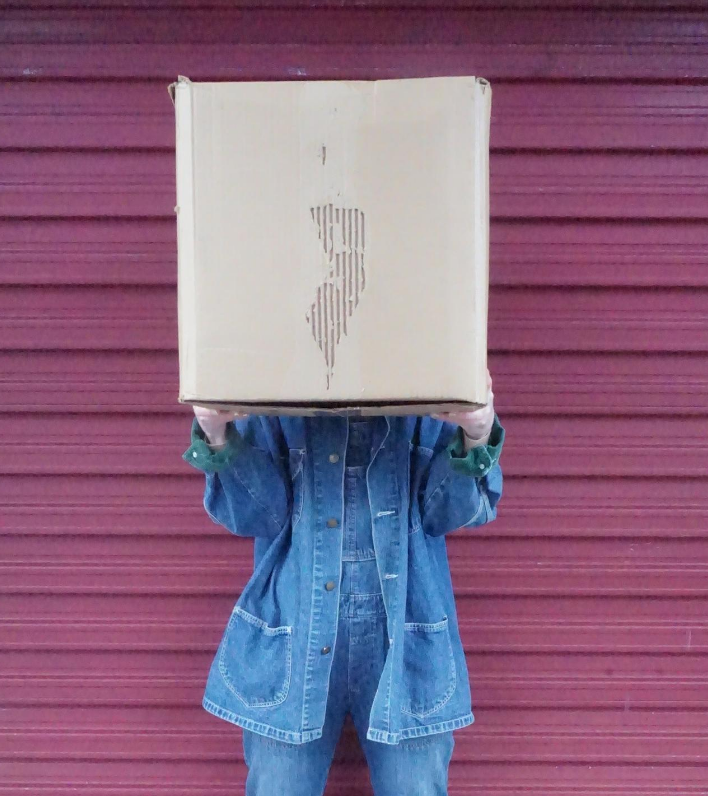
[Storage] began with Bare Portland company member Tarra Bouchard’s concept: find a storage unit at auction and use the contents to create an immersive performance and installation. How many units were evaluated? How did you decide on the final unit?
Tarra: We ended up going to 4 auctions total and looked at a lot of units. But the decision on the final unit was made for us.
Kerry: I did a lot of online research ahead of time – Scrolling through to see what auctions were happening at a time and place that some of us could make it. Then made tons of phone calls to storage companies all round the state trying to understand the circumstances that compel them to hold auctions and if there were any coming up we could attend.
Tarra: We only had $50 to spend and we came not knowing exactly what to expect. None of us had done this before and we didn’t know we were going to walk away that day with a unit.
Dana: $50 is very low for an auction. We knew being able to get a unit for that was going to be tough for us. Out of hundreds of units in that building we went to, at least 30 were for auction that day.
The whole process goes very quickly: They staff open the door to the unit and a lot of people who were there with us immediately flicked on flashlights or headlamps- we were very much the newbies amongst some very seasoned storage unit auction go-ers. You are not allowed to touch any of the items in the unit until you successfully win the bid and it becomes yours. It is a very quick 30 seconds to look around and then place your bid.
Catherine: People are throwing out numbers all around you- hundreds of dollars. There are people there who know immediately if something is worth bidding on.
Kerry: It was funny too, because we had a meeting the night before where we talked about trying to get something manageable. But the unit we found we had an actual chance of getting (because no one wanted it) was a 20’ x 10’ unit PACKED with stuff. Stuff was literally falling out of the unit.
Everyone at the auction thought it was trash. And then we lost the bid to someone anyway. We didn’t jump on it the way they did, but we approached him afterwards and asked if we could give him $25 to help clean it up and keep some of the belongings. He said sure.
Catherine: He and his buddy were there. They moved from South Carolina to Maine because the storage industry was better here- that is how deep in this world they are. They dove into the unit and went through things so quickly. They were convinced that there would be treasure there. He eventually sent me a text saying “it’s all yours, it’s just junk”.
Because the unit was so large and so full of stuff- small boxes, papers between the boxes, every inch was accounted for. They gave us 3 weeks to clear it out. This unit was notorious at the facility.
Dana: It took us 100+ hours to clean it all out. Countless car trips. It is important to note throughout the auction process, we didn’t pay for the stuff. We paid for dump fees, but it was really labor and time.
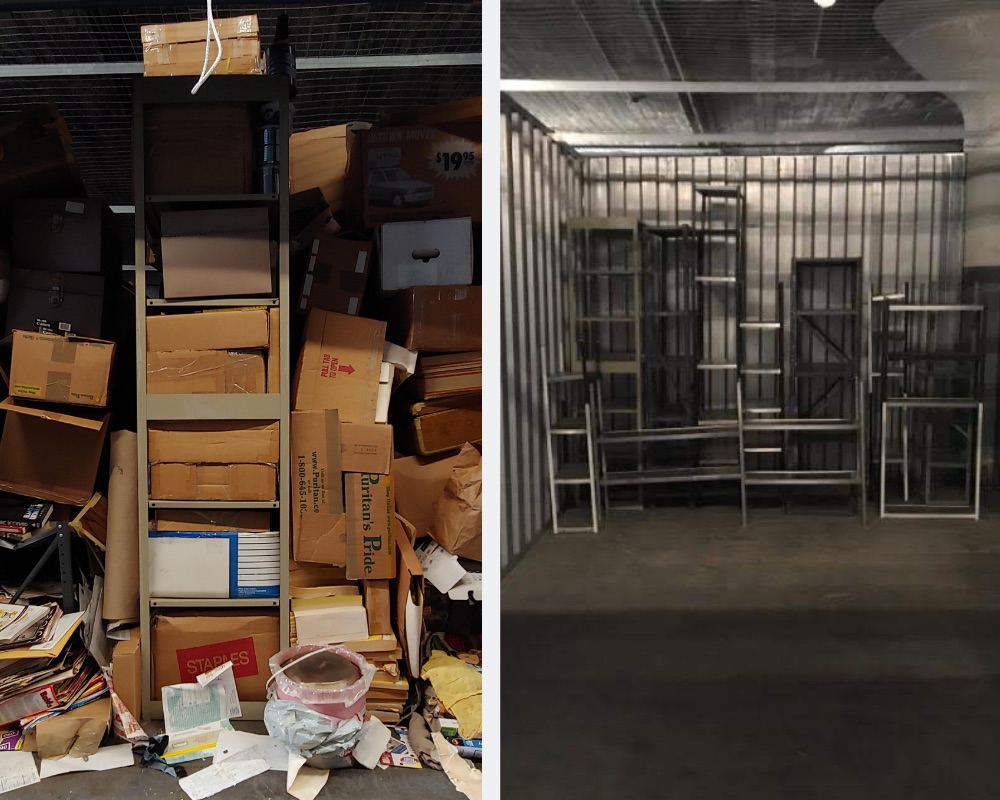
This project calls up a lot of larger national intersecting issues: our culture of stuff, the precarity of affordable housing under the pressures of gentrification, and also mental health and the barriers to affordable mental healthcare. By securing a unit in Bayside, is your intention to increase awareness about how these issues manifest locally and who is most impacted? Do you hope to ignite conversations about specific civic engagement?
Tarra: These conversations are already happening. It is our hope to allow a larger part of the community to be a part of them outside of the casual observer. A lot of us are directly affected, more so now that we have been a part of this project for a year. Hopefully this will be a jumping off point for more conversations to be had louder to more audiences. This conversation has been going on for so long-in Bayside since the 70s. For me personally, I just left Portland after 15 years because I can’t afford to live here anymore.
James: We stumbled into an ethnography of the area essentially. That is really compelling to us as we go forward. It is telling a specific, place-based multitude of stories.
Dana: This particular owner of the unit was very concerned with the changing Portland landscape too- the number of documents about how Portland had changed in the last decade was significant.
That was the hope in the inception of the project- to broaden the conversation to other individuals. This change is very real- how do we heighten awareness about it.
Catherine: We knew though that we can’t write the comprehensive story of the changing Portland and we can’t write even this one person’s story. That is really the conceit of the final project- that this stuff holds so many different stories within it. Lets let some writers create a story. Let the exhibition tell the stories. Someone could resonate with the stories about the changing Portland. Someone else might resonate with a story about mental health, specifically the desire to diagnose or not diagnose. Someone else could be affected by the way this work talks about hoarding and that specific trauma. Hopefully it provides a platform for people to find their own story in these issues.
Tarra: The moral ambiguity of creating art on this level is so high- is it ethical? What we draw from that is its own can of worms.
Dana: The idea too of it being not just a play but also an interactive installation, allows people to go through it and find their own throughlines.
James: One of the inspirations we have taken in trying to stage this thing, is that the process of unpacking it and exploring it has been so inherently voyeuristic. That naturally lends itself to having the audience feel culpable in a lot of ways. Everyone is implicated in this. One of the things that Douglas said in one of our first read-throughs was that writing this play is encouraging people to approach others with compassion and grace. What I take from that is instead of us trying to answer, “what did you find in the unit”, instead we are trying to ask the audience” What have you found here”, in all these different stories we have shared.
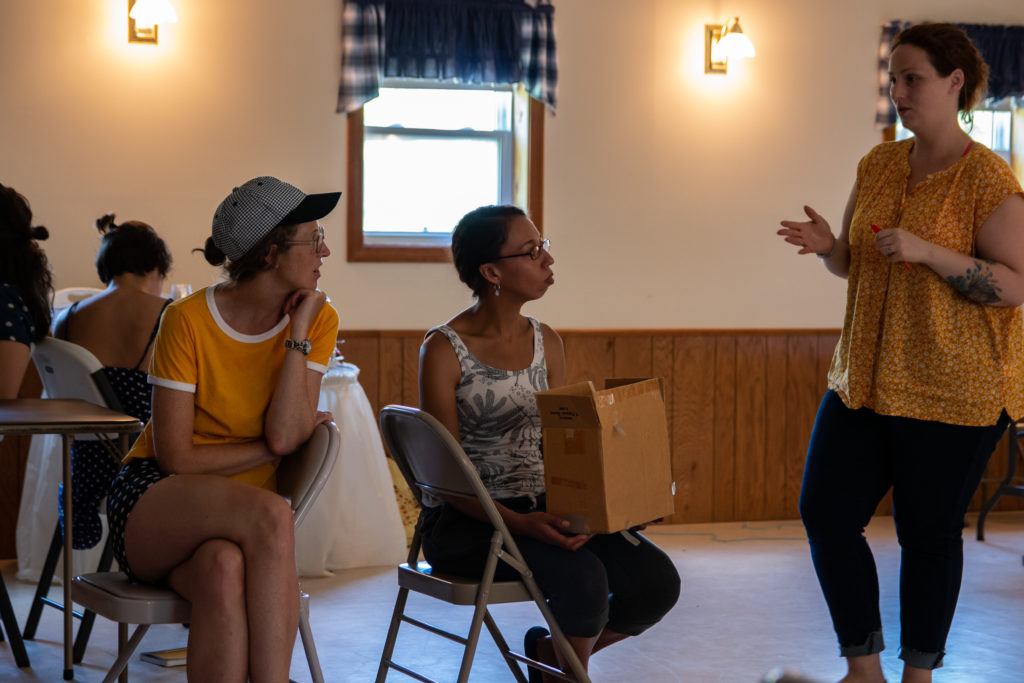
How have you centered respect and dignity for the unit’s owner throughout the process? Even though what is coming up is so relatable to a wide range of people, you are still going through one person-or family’s- private things.
Douglas: The final movement exercise we did in Sydney comes to mind, where we were interacting with a lot of these different objects. Trying to invite different ways to explore this material. By the end of it, everyone who was involved, even though we were so compelled by the mystery of who the storage unit owner is, decided that the absolute wrong thing to do would be to write a play that solves that mystery. That wasn’t the point.
I can’t speak for the other 2 writers, but for me it ended up inverting itself and going the opposite direction: Instead of exploring who this person was, we are exploring the very nature of identity. There was so much material there, but you could see conflicts, the very stuff was in conflict with one another. There was clear tension there and that felt like a very real parallel to how identity operates.
Mackenzie: We did all the things that you do to try to protect anonymity- we had a lot of people sign confidentiality agreements. It became really important to us that when we were talking about the show to ask ourselves, “what if the unit’s owner came? How would they feel about what was produced?” It is a very real possibility.
That idea is terrifying and thrilling for sure. But it is also helpful to consider that as we near the final project right now. This person identifies themselves as an artist – these objects were important to them, and normally these are things that would just end up in the dump. We are giving them another artistic frame, and another life. That is how I have been going through it creatively.
We also recently brought in Sarah Schindler, a law professor from USM and we talked to her all about ownership and its very vague and ambiguous nature legally. That was really helpful to think through- this was all stuff collected by this person in one space, but it doesn’t necessarily mean that they own it. We found other people’s mail in the unit, a child’s homework, so who does that belong to?
Dana: Even now this stuff is technically ours, but it’s really not mine. And very soon, it’s not going to be ours, it will be someone else’s responsibilities.
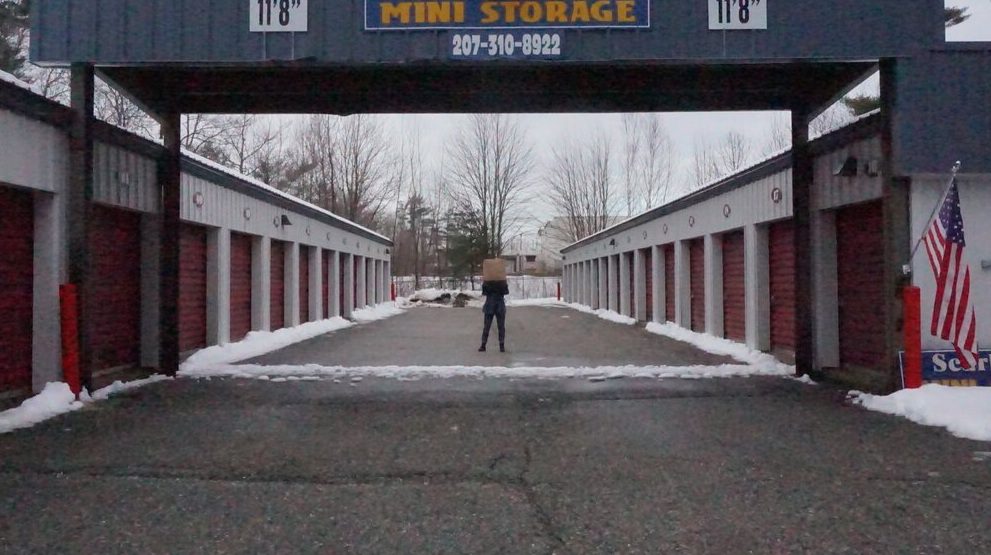
How do you prepare for interactive performances, where the nature of audience participation/contribution is largely unknown? Specifically, how do you navigate the potential that this could be triggering to someone with lived experience of housing instability?
James: We talked about that a lot from the beginning and we have been doing a lot of work beforehand. In addition to Sarah Schindler we also worked with Joe Guglielmetti.
Kerry: He is a social worker at Preble Street. He has veteran specific experience and housing issues: helping veterans secure housing and during periods of precarity. He came to speak to the group about issues his clients face and his background in working with people who deal with hoarding and the intersections of hoarding and losing housing. It was really important to hear from him and his perspective on things to keep in mind when exploring these issues.
Tarra: Joe talked to us about specific things that could be triggering- things that were often left or often discarded. Of course that information is a microcosm, at least for our very local experience, it was something that was really helpful to talk through.
James: Absolutely, and I keep reminding myself that the whole experience is designed to promote conversation and interaction. And not just a transactional relationship of consuming the piece. Our hope is that people come early, mingle, explore the installation ahead of time which will share a lot of context for the project. They will have a sense of the process that went into making this work and they won’t be going in blind.
One of the things that we are also focused on in regards to how the audience interacts with this, is trying to delight them as much as possible and also take care of them. We have one character designated as a tour guide.
Kate: Yes, and there are so many fun moments of play and comedy throughout. The actors will take care of the audience the whole time. No one will be forced to do anything they are resistant to, it is very much a choose your own adventure experience.
Kerry: The reality of the situation in Bayside and gentrification in general, is that we are all culpable in those intersecting forces and we are all a part of it. Making the audience present and participatory in the work mirrors that nature of the issues we are exploring.
James: I keep referring to it as “Come swim in the ethical pool with us”. As soon as you buy the ticket and enter, you are part of this.
Dana: The actual performance is very much fiction though. Who knows, everyone will react differently. I think if an audience member came who didn’t know the whole process, the performance itself would stand on its own. It is very connected to the process, but it is its own fictional story.
What I think is really neat about holding this performance here in an alternative space- a closed former school building- is that If someone feels uncomfortable in the room and wants to leave, they can. It is not a formal theater. But also, this whole building in my mind is part of the greater story too. When you step outside of our set, you can continue to question this closed former school building we are in, that transitioning nature of this space, and beyond.
James: Our hope is that afterwards people will stay to talk and look more. The performance is just one piece of it, but folks can explore the set as well. It is all anonymized and can be examined closely. The beauty is in the details of what Dana has been putting together.
This project involves 18 different artists working across a range of mediums. What impacts do you feel on the work with that many contributors?
Catherine: In addition to company members who emptied the unit, to performers, stage manager, writers, editors, production managers, artists, there have also been friends and partners who have been open and curious about what we are doing and want to help. At least 50 people have touched this project in some way.
Dana: It really goes back to the community to me. This is an art project but it is also about getting to know people who live in the same city. Sharing this task of sifting through these things and having conversations around that. Back to Douglas’ point of building compassion for others too- this project isn’t just us as Bare Portland working on a new play, it’s us collaborating with as many people as possible in a way that feels more like real life and civic engagement. I guess it is social practice.
Catherine: Everyone has a story as we tell them about this project. It has been a kind of hoarding of stories. The grandmother who is a hoarder or the storage unit their family still has. So many people connect and are entangled in these issues.
Tarra: This project is so big because we delegated a lot and we have relied on the strengths of the many people involved. It was intentional that the writers are not also the people who emptied the storage unit. It was intentional that it was different people doing the acting than the writers and storage coordinators. It was intentional that we have writers from the Telling Room do some devising for us because they are really imaginative writers. That was a practice for all of us that is really new. Instead of trying to do it all, and stretching beyond our skill sets, we really let people use their talents as wisely as possible.
James: I think it has made the whole process so much richer, more collaborative, and much less hierarchical. Embracing the idea of collective brilliance, that no one person can have their thumb on everything, but believing in the group’s assembled skill.
Dana: It is also the longest process we have ever taken. Everything the past year that anyone has done with Bare Portland has been up leading up to [Storage].
Is there anything else you want people to know about [Storage] at this point before it opens on March 5th?
James: Tickets are now on sale. Each performance has 30 people per show. We are encouraging people to pay either a $20 ticket or $10 depending on what is comfortable for them. We do also have some free tickets we are giving away to community members. We really want people to come early and stay late.
Tarra: In the end, we aren’t here to tell one specific story and we want people to explore on their own. It is an opportunity to think about your own connection to this place too. There is some real Portland history in the Unit, it is a real time capsule that everyone will have different connections to.
PERFORMANCE DETAILS
More information at www.bareportland.org
Dates: March 5-7 (Thu-Sat), March 11-15 (Wed-Sun), March 18-21 (Wed-Sat) all at 7:30
Tickets: $10-20, pay what you can options available.
Purchase at: https://bare-portland.ticketleap.com/storage/
Location: Stevens Square Community Center (former Maine Girls Academy), 631 Stevens Ave (use Walton Street parking lot & entrance)
Content Warning: the performance contains references to sexual violence and sexual assault, non-consensual drugging, and pornographic images. The performance is recommended for viewers that are 18+.

